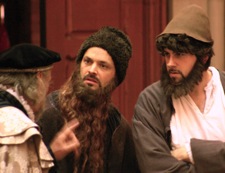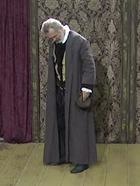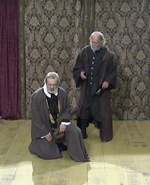- Edition: King Leir
King Leir
- Introduction
- Texts of this edition
- Contextual materials
- Facsimiles
155King Leir, Scene 23
Cast Mariner 2: Jason Gray
Mariner 1: David Kynaston
Perillus: Peter Higginson
King Leir: Don Allison
The king divesting himself of his clothes would have been a highly provocative image in a society that upheld sumptuary laws tying clothing tightly to social status. The SQM company tried to bridge this cultural distance in their performance of this scene.
Queen's Men Dramaturgy: Medley Style (Sc. 23)
156Read about the Queen's Men's medley style in Scene 22
The mariners' colloquial prose and transparent cunning invite comic treatment. Their argument that a "good, strong, motley gaberdine" (TLN 2009-10) and a "good sheep's russet seagown" (TLN 2014-15) might be a fair exchange for the royal cloaks worn by Leir and Perillus is a transparent deception, confirmed by their hasty exit before they "repent them of their bargain" (TLN 2032). The exchange sets a light tone for the scene regardless of the dire condition of the protagonists. The exchange of clothing would likely have been more striking for the original audience familiar with early modern sumptuary laws that bound clothing to status. Much of the resonance of this moment may have be lost to our audience today but we tried to enhance the emotional affect of the king donning the scruffy and weatherworn clothing of the mariners in performance. Peter Higginson's emotive response as Perillus to his master's new attire helped bring the social significance home to our contemporary audience, and the image of Don Allison struggling into his "motley gaberdine" (TLN 2010) was bathetic, signifying his great loss of status and giving him a foolish appearance. Humour and sympathy intertwined beautifully in what was for me one of the most touching moments in the show.
Read about the Queen's Men's medley style in later scenes
Watch video of Scene 23 on the Performing the Queen's Men website. (The video footage is password protected. Click on "Cancel" in the pop-up window to obtain password.)
Performing Leir (Sc. 23)
157Read about performing Leir in Scene 19
Don Allison, playing Leir, increased the sense of his character's age as the play progressed. In this scene, Perillus takes the initiative and agency in his negotiations with the mariners while Leir passively accepts their exchange and the loss of status it implies. In performance, Don gave the moment a sense that Leir was embracing the transformation from king to clown. The text notes that the cloak and hat are a convenient disguise (TLN 2028-30) but Don gave the impression that Leir found the clownish clothes fitting, at a deeper level, as a reflection of his foolish and downtrodden self.
Read more about performing Leir.
Queen's Men Dramaturgy: Rhetoric and Emotion (Sc. 23)
158Read about Rhetoric and Emotion in Scene 14
Leir and Perillus once more engage in a rhetorical game in which the king talks his way towards despair and his old friend brings him back to hope. This passage is perhaps the most beautiful example (TLN 2046-2072). Perillus picks up on all the material references in Leir's extended metaphors and neatly ties up his counter-argument in his final rhyming couplet: "Yet she'll continue in her former state,/ The honey, milk, grape, sugar, mithridate" (TLN 2071-2). Leir explicitly acknowledges the power of rhetoric calling Perillus a "pleasing orator" (TLN 2073). In performance, the characters' awareness of the rhetorical form of their exchange was matched by the actors' self-conscious manipulation of the language.
The Queen's Men and Shakespeare (Sc. 23)
159Read about the Queen's Men and Shakespeare in Scene 19
This scene between the two old men was touching in performance and reminiscent of Shakespeare's scenes on the heath between Lear and Gloucester with its combination of sympathy and painful comedy. Perillus' distress seeing his king in "such extremity" (TLN 2088) recalls Gloucester's response to Lear's madness that prompts Lear's famous line: "I, euery inch a king" (TLN 2554). Don's performance of Leir in "motley gaberdine" conjured the idea of a king recognizing his mortality. I find it hard to imagine that the emotional quality of this section of the Queen's Men play did not color Shakespeare's creative process when tackling the same stage of the king's journey, or that the exchange of clothes in this scene did not inspire Lear's unbuttoning on the heath.
Read more about the Queen's Men and Shakespeare.
Watch video of Scene 23 on the Performing the Queen's Men website. (The video footage is password protected. Click on "Cancel" in the pop-up window to obtain password.)






